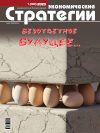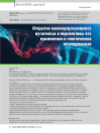Discovery of Nanocorpuscular Mutagenesis and Prospects for its Application in Genetic Studies
DOI: 10.33917/es-1.187.2023.78-85
Nanocorpuscular mutagenesis is the property of nanoparticles and/or nanomaterials to induce genetic changes or mutations.
Research on this newly discovered phenomenon will certainly expand the sphere of activity of geneticists and biologists, since scientists will have new tools at their disposal. Ideally, these studies will create a fundamentally new experimental basis for deeper understanding of the development processes in a living matter, and will complement our knowledge of what can and cannot be done with nature. In theoretical terms, it can also be admitted that the means of nanocorpuscular mutagenesis would pave a new way to obtaining and understanding such genetic and biological forms that favourably differ from those, which served as the basis for natural selection on our planet for hundreds of millions of years. From a practical point of view, one might expect that methodology of nanocorpuscular mutagenesis in combination with other progressive research methods will open up new interesting prospects in the field of genetic technologies, aimed, as is known, at solving such global, vital problems as:
– induction of hereditary immunity;
– fight against viral and oncological diseases;
– creation of new unique varieties of cultivated plants and animal breeds with such features that will be extremely useful and valuable for agricultural economy.
In other words, nanocorpuscular mutagenesis is likely to become another means of deep reformation of the fundamental apparatus of heredity and, as a result, transformation of the living systems’ ontology and will also make a valuable contribution to genetic science by discovering new, hitherto unknown phenomena and patterns.
References:
1. Zakhidov S.T. Mutatsionnaya nanogenetika v sisteme nanotekhnologii [Mutational Nanogenetics in the System of Nanotechnologies]. Nanotekhnologii i okhrana zdorov’ya, 2010, no 3(4), pp. 28–43.
2. Zakhidov S.T. Vystuplenie na zasedanii Prezidiuma RAN 13 oktyabrya 2013 g. v ramkakh obsuzhdeniya nauchnogo soobshcheniya Yu.M. Evdokimova “Strukturnaya nanotekhnologiya nukleinovykh kislot: sozdanie ‘zhidkikh’ i ‘tverdykh’ nanokonstruktsii DNK”: Stenograficheskii otchet [Speech at the meeting of the Presidium of the Russian Academy of Sciences on October 13, 2013 as part of discussion of the scientific report by Y.M. Evdokimov “Structural Nanotechnology of Nucleic Acids: Creation of ‘Liquid’ and ‘Solid’ DNA Nanostructures”: Verbatim Report]. Vestnik Rossiiskoi akademii nauk, 2014, vol 84, pp. 20–33.
3. Zakhidov S.T. O nanotekhnologiyakh v sisteme nauk [About Nanotechnologies in the System of Sciences]. Vestnik R ossiiskoi akademii nauk, 2021, vol. 91, no 3, pp. 289–292.
4. Rapoport I.A. Khimicheskii mutagenez: teoriya i praktika [Chemical Mutagenesis: Theory and Practice]. Moscow, Znanie (repr. izd.), 2013, 86 p.
5. Kohl Y., Runden-Pran E., Mariussen E., et al. Genotoxicity of Nanomaterials: Advanced In Vitro Models and High Throughput Methods for Human Hazard Assessment: A Review. Nanomaterials, 2020, vol. 10, no 10.
6. Evdokimov Yu.M. Nanochastitsy zolota “upravlyayut” upakovkoi DNK [Gold Nanoparticles ‘Manage’ the DNA Packaging]. Priroda, 2015, no 4, pp. 13–21.
7. Skuridin S.G., Dubinskaya V.A., Shtykova E.V., et al. Fiksatsiya nanochastits zolota v strukture kvazinematicheskikh sloev, obrazovannykh molekulami DNK [Fixation of Gold Nanoparticles in the Structure of Quasi-Nematic Layers Formed by DNA Molecules]. Biologicheskie membrany, 2011,
vol. 28, pp. 191–198.
8. Yevdokimov Y.M., Skuridin S. G., Salyanov V. I., et al. A Dual Effect of Au-Nanoparticles on Nucleic Acid Cholesteric Liquid-Crystalline Particles. Journal of Biomaterials and Nanobiotechnology, 2011, vol. 2, pp. 461–471.
9. Aydin A., Sipahi H., Charehsaz M. Nanoparticles toxicity and their routes of exposures. Recent Advances in Novel Drug Carrier Systems (edited by Ali Demir Sezer), Publisher: InTech., 2012, pp. 483–500.
10. Di Bucchianico S., Fabbriz M.R., Cirillo S., et al. Aneuploidogenic effects and DNA oxidation induced in vitro by differently sized gold nanoparticles. International Journal of Nanomedicine, 2014, vol. 9, pp. 2191–2204. 11. Doak S.H., Liu Y., Chen C. Genotoxicity and Cancer. Adverse Effects of Engineered Nanomaterials, Elsevier Inc., 2012, pp. 243–261.
12. Ng C-T., Li J.J., Bay B-H., Yung L-Y.L. Current studies into the genotoxic effects of nanomaterials. Journal of Nucleic Acids, 2010, Article ID 947859, 12 page shttp: //dx.doi.org/10.4061/2010/947859.
13. Yao Y., Costa M. Genetic and epigenetic effects of nanoparticles. J. Mol. Genet. Med., 2013, vol. 7, pp. 1–6.
14. Vecchio G., Galeone A., Brunetti V., et al. Mutagenic effects of gold nanoparticles induce aberrant phenotypes in Drosophila melanogaster. Nanomedicine: Nanotechnology, Biology and Medicine, 2012, vol. 8, pp. 1–7.
15. Rapoport I.A. Mikrogenetika [Microgenetics]. Moscow, Nauka (repr. izd.), 2010, 530 p.
16. Zakhidov S.T., Mudzhiri N.M., Rudoi V.M., Dement’eva O.V., Makarov A.A., Zelenina I.A., Marshak T.L. Nanochastitsy zolota: mutagen, antimutagen, komutagen? [Gold Nanoparticles: Mutagen, Antimutagen, Comutagen?]. Izvestiya RAN, 2017, no 3, pp. 213–217. (Seriya biologiya.)
17. Mudzhiri N.M., Zakhidov S.T., Rudoi V.M., Dement’eva O.V., Makarov A.A., Makarova I.V., Zelenina I.A., Andreeva L.E., Marshak T.L. Tsitogeneticheskaya aktivnost’ nanochastits zolota v polovykh i somaticheskikh kletkakh myshei linii 129 s nonsens-mutatsiei v gene DNK-polimerazy iota [Cytogenetic Activity of Gold Nanoparticles in Germ and Somatic Cells of Mice of Line 129 with a Nonsense Mutation in the Iota DNA Polymerase Gene]. Izvestiya RAN, 2018, no 2, pp. 137–143. (Seriya biologiya.)
18. Pan B., Kaldone P.R., Alund A.W., Du H., et al. Mutagenicity of silver nanoparticles evaluated using whole-genome sequencing in mouse lymphoma cells.
Nanotoxicology, 2021, vоl. 15, pp. 418–432.
19. Suzuki T, Miura N., Hojo R., et al. Genotoxicity assessment of titanium dioxide nanoparticle accumulation of 90 days in the liver of gpt delta transgenic mice. Genes and Environment, 2020, vol. 42, pp. 2–6.
20. Rapoport I.A. Otkrytie khimicheskogo mutageneza [Discovery of Chemical Mutagenesis]. Moscow, Nauka, 1993, 304 p.
21. Wang Z., Tang L. Huey L., et al. Discovery of the DNA “Genetic Code” for Abiological Gold Nanoparticle Morphologies. Angew chem. Int. Ed. Angl., 2012,
51(36), 9078–9082; tsit. po: https://smotrim.ru/article/1372563.
22. Rapoport I.A. Razvitie struktury kompakta Diraka v geneticheskom stroenii [Development of the Dirac Compact Structure in the Genetic Structure]. Sb.: Primenenie khimicheskikh mutagenov v sel’skom khozyaistve i meditsine [Applying Chemical Mutagens in Agriculture and Medicine]. Moscow, Nauka, 1973, pp. 7–46.



